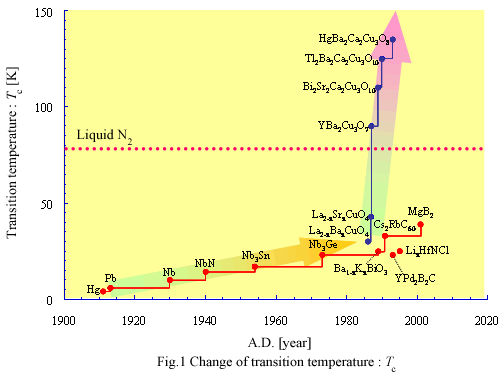 |
||||||||||
Development of superconductor has started since the discovery of superconductivity in Hg (Tc = 4 K). Fig.1 shows changes in superconducting transition temperature.

As we look at Fig.1, the element superconductor's transition temperature began to increase just after the discovery of superconductivity in Hg. Superconducting temperature increased to 9.2 K in Nb, thanks to the advance in helium liquefaction technique in 1930.
After 1930, the alloy and intermetallic compound superconductors were discovered. Material group having B1 structure (NaCl-type structure) marked a new record of Tc. In this system, NbN[1] has maximum Tc (Tc = 17.3 K). Superconductivity in NbN was discovered in 1940. In the 1950's, superconductor with A-15 structure was discovered. As the 20 K superconductivity in Nb3Sn[2] was discovered in this system, A-15 material group became a mainstream in searching new superconductors. As the results, Tc increased at 23.3 K in Nb3Ge[3] among the middle 1970's.
In 1986, superconductivity in La-Ba-Cu-O was discovered by J,Bednorz and K.Muller. And this is the beginning of copper-oxide superconductor age. After the discovery, La-Ba-Cu-O composition was determined to be La2-xBaxCuO4. Surprisingly the La2-xBaxCuO4 showed superconductivity at near 40 K which was maximum record at that time. This discovery triggered dramatic increasing of maximum Tc. After the 1 year later, 90 K superconductivity in YBa2Cu3O7-d[5] was discovered. YBa2Cu3O7-d[5] is first superconductor with Tc above liquid nitrogen melting point. Moreover, 100 K-class superconductors, such as BiSr2Ca2Cu3O10[6] and Tl2Ba2Ca2Cu3O10[7] were discovered after two years later. In this time, HgBa2Ca2Cu3O1[8] has maximum record (Tc = 164 under high-pressure). Discovery of copper-oxide superconductor changed ratio of increasing Tc . The increasing Tc ratio was 1 K/ 3 years before 1986. After in 1986, the ratio increased drastically. Discovery of copper-oxide superconductors have a large impact on searching superconductor.
During copper-oxide superconductors fever, relatively high-Tc superconductors were also discovered in oxide and intermetallic compounds. These superconductors has unique physical and structural character. In 1988, Ba1-xKxBiO3[9] showed superconductivity at 30 K. The oxide forms perovskite structure as same as copper-oxide superconductor and it marked maximum-Tc in oxide compounds, excepting for copper-oxide. It is often said that Ba1-xKxBiO3[9] superconductivity state is related to CDW( = Charge Density Wave). In 1990's, the first attracted material was Fullerene (C60). C60 is consist of sixty carbons connecting soccer ball form. C60 is large molecular compared with normal ion. C60 made crystal structure connecting alkali metal which has a large ion radius and composition A3C60. Maximum Tc in fullerene compound is 33 K in RbCsC60 [10]. In 1944, new borocarbide compounds having layered structure, such as YNi2B2C (Tc = 15.4 K)[11] and YPd2B2C (Tc = 23 K)[12], were discovered. And in 1988, layered nitride LixHfNCl(Tc = 25.5 K)[13] was also discovered. These superconductors had comparable high Tc like Nb3Sn ( Tc = 23.3 K ) which had Tc record in intermetallic compounds at that time. At the beginning of the 21st century, MgB2 superconductor at 39 K was discovered. The Tc is twice lager than maximum Tc in intermetallic superconductor Nb3Ge at that time. Now, MgB2 has Tc record in intermetallic superconductors.
[1] Aschermann, Friederich, Justi and Kramer, Z. Phys. 42 (1941) 349
[2] B. T. Matthias et al., Science 156 (1967) 645
[3] J. R. Gavaler, Appl. Phys. Lett. 23 (1973) 480
[4] J. G. Bednorz and K. A. Müller, Z. Phys. B64 (1986) 189
[5] M. K. Wu, J. R. Ashburn, C. J. Thorng, P. H. Hor, R. L. Meng, L. Gao, Z. J. Huang, Y. Q. Wang and C. W. Chu, Phys. Rev. Lett. 58 (1987) 908
[6] H. Maeda, Y. Tanaka, M. Fujitomo and T. Asano, Jpn. J. Appl. Phys. 27 (1988) L209
[7] Z. Z. Sheng and A. M. Hermann, Nature 332 (1988) 138
[8] L. Gao et al., Phys. Rev. B 50 4260 (1994)
[9] R. J. Cava et al., Nature 332 (1988) 814
[10] K. Tanigaki et al., Nature 352 (1991) 222
[11] R. J. Cava, H. Takagi, H. W. Zanbergen, J. J. Krajewski, W. F. Peck, T. Siegrist, B. Batlogg, R. B. van Dover, R. J. Felder, K. Mizuhashi, J. O. Lee, H. Eisaki and S. Uchida, Nature 367 (1994) 252
[12] R. J. Cava, H. Takagi, B. Batlogg, H. W. Zanbergen, J. J. Krajewski, W. F. Peck, R. B. van Dover, R. J. Felder, T. Siegrist, K. Mizuhashi, J. O. Lee, H. Eisaki and S. Uchida, Nature 367 (1994) 146
[13] S. Yamanaka et al., Nature 392 (1998) 580
[14] J. Nagamatsu, N. Nakagawa, T. Muranaka, Y. Zenitani and J. Akimitsu, Nature 410 (2001) 63